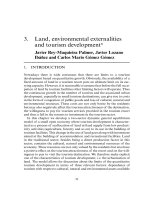THE ECONOMICS OF MONEY,BANKING, AND FINANCIAL MARKETS 493
Bạn đang xem bản rút gọn của tài liệu. Xem và tải ngay bản đầy đủ của tài liệu tại đây (61.2 KB, 1 trang )
CHAPTER 17
Tools of Monetary Policy
461
2. During the holiday season, when the public s holdings of currency increase, what open market operations typically occur? Why?
*9. Last-resort lending is no longer needed because the
presence of the CDIC eliminates the possibility of
bank panics. Discuss.
*3. If the government has just paid for major computer
upgrades and as a result its deposits with the Bank
of Canada fall, what open market operations could
be undertaken?
10. The benefits of using last-resort lending to prevent
bank panics are straightforward. What are the costs?
4. In the LVTS environment, government deposit
shifting is effected by auctions of government balances. Discuss.
*5. Most open market operations are currently repurchase agreements. What does this tell us about the
likely volume of open market operations relative to
dynamic open market operations?
*11. You often read in the newspaper that the Bank of
Canada has just lowered the target overnight rate.
Does this signal that the Bank is moving to a more
expansionary monetary policy? Why or why not?
12. How can the procyclical movement of interest rates
(rising during business cycle expansions and falling
during business cycle contractions) lead to a procyclical movement in the money supply as a result
of the Bank of Canada s lending policy? Why might
this movement of the money supply be undesirable?
6. The only way that the Bank of Canada can affect
the level of advances is by adjusting the bank rate.
Is this statement true, false, or uncertain? Explain
your answer.
*13. Explain how repos and reverse repos affect the
overnight rate.
*7. If the Bank of Canada did not administer the operating band what do you predict would happen to
the money supply if the bank rate were several percentage points below the overnight rate?
14. The channel/corridor system for setting interest
rates enables the Bank of Canada to set the
overnight rate whatever the demand for reserves,
including zero demand. Discuss.
8. Discuss how the operating band affects interest
rates and the money supply in the economy.
*15. Compare the use of open market operations and government deposit shifting to control the money supply,
using the following criteria: flexibility, reversibility,
effectiveness, and speed of implementation.
Q U A N T I TAT I V E P R O B L E M
CANSIM Question
1. Get the daily CANSIM data from January 2, 1996, to
November 11, 2009, for the bank rate (series V39078)
and the target overnight rate (series V39079) from
the Textbook Resources area of the MyEconLab.
a. What is the difference between the two series?
b. Plot the two series.
c. Calculate the upper and lower bounds of the
operating band and plot the time path of the
operating band.
d. What does the time path of the operating band
say about the easiness of monetary policy over
this period?
WEB EXERCISES
1. Go to www.bankofcanada.ca and click on Media
Room and then Press Releases. Scroll down and
click on the release regarding recent changes in the
overnight rate of interest. Summarize the statement
in one paragraph. Be sure to note whether the bank
rate was increased or decreased. Now review the
changes in the operating band for the overnight
interest rate in the previous two press releases
regarding this issue. Has the stance of monetary
policy changed?
2. Refer to Figure 17-1 on page 434. Go to
www.bankofcanada.ca and scroll down on Rates
and Statistics. What is the current overnight rate
target? What is the overnight rate? Is the difference
between them what you would expect it to be?
Be sure to visit the MyEconLab website at www.myeconlab.com.This online
homework and tutorial system puts you in control of your own learning with
study and practice tools directly correlated to this chapter content.









